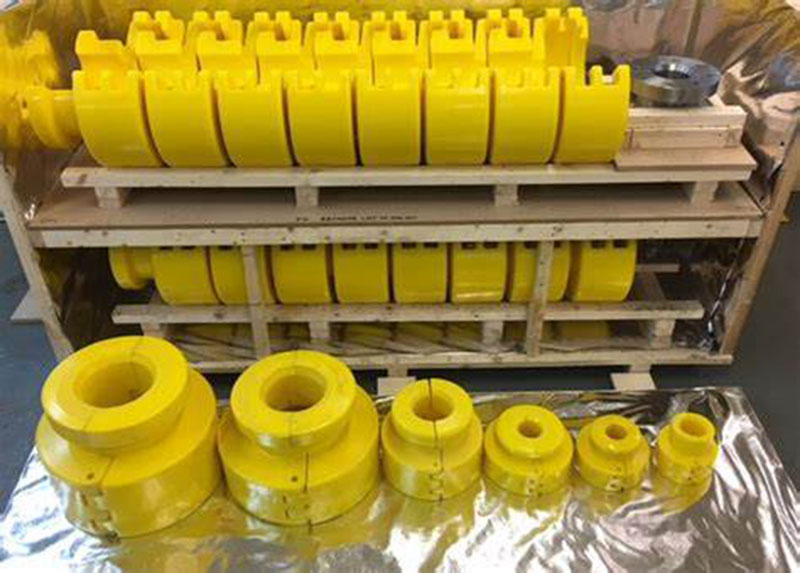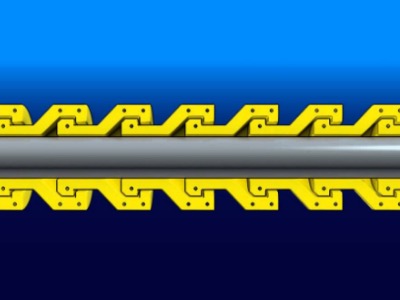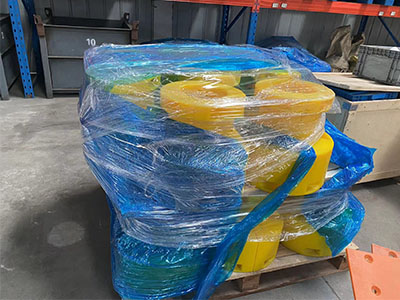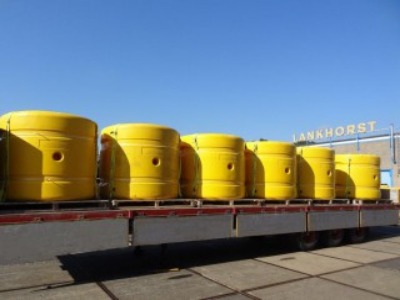Polyurethane bend restrictors, also known as cable bend limiters, are protective devices designed to prevent subsea cables and umbilicals from exceeding their minimum bend radius under dynamic loads. They consist of interlocking, segmented elements that provide controlled flexibility in normal conditions and form a semi-rigid structure when bending forces approach critical limits.

In offshore projects—whether in wind farms, oil & gas platforms, or subsea communication networks—bend restrictors play a crucial role in ensuring cable integrity, reducing fatigue, and extending service life.
Why is polyurethane used?
Polyurethane is the preferred material for bend restrictors due to its exceptional balance of strength, flexibility, and environmental resistance. Unlike metals, it offers lighter weight and easier handling without sacrificing durability.
Advantages of polyurethane in subsea applications include
High hydrolysis resistance – withstands prolonged seawater exposure.
UV resistance – maintains performance even in surface or shallow-water installations.
Excellent resilience – absorbs impact and returns to shape without permanent deformation.
Abrasion and tear resistance – protects against wear from continuous movement.
Environmental friendliness – modern formulations can be recyclable and free from harmful additives.
Weight reduction – easier transport and faster offshore installation compared to heavy metallic protectors.
Available polyurethane material types
Philson offers bend restrictors manufactured from various polyurethane formulations to match specific project requirements:
MDI (Methylene diphenyl diisocyanate) – high mechanical strength and wear resistance, suitable for heavy-duty offshore environments.
PPDI(P-phenylene diisocyanate) – superior thermal stability and abrasion resistance, ideal for high-temperature or high-load conditions.
NDI (Naphthalene diisocyanate) – outstanding fatigue resistance and dimensional stability, excellent for long-term dynamic loading.
TDI (Toluene diisocyanate) – cost-effective option with good flexibility and resilience for less demanding applications.
Each type can be customized for shore hardness, elasticity, and color to meet project-specific needs.
Polyurethane bend restrictors combine durability, environmental resistance, and cost efficiency, making them an indispensable part of modern subsea cable protection systems. By selecting the right polyurethane type—MDI, PPDI, NDI, or TDI—operators can achieve maximum reliability and service life while reducing maintenance and replacement costs.
Philson manufactures high-quality polyurethane bend restrictors tailored for your offshore projects. Contact us for custom designs, material recommendations, and technical support.
Common different sizes of bending restrictor
Product | Cable | Length | Material | Hardness |
Bend restrictor 3*70 | 3*70cable | 5M/8M | High-performance polyurethane PU | Shore 83D(Customizable) |
Bend restrictor 3*80 | 3*80cable | 5M/8M | High-performance polyurethane PU | Shore 83D(Customizable) |
Bend restrictor 3*120 | 3*120cable | 5M/8M | High-performance polyurethane PU | Shore 83D(Customizable) |
Bend restrictor 3*185 | 3*185cable | 5M/8M | High-performance polyurethane PU | Shore 83D(Customizable) |
Bend restrictor 3*200 | 3*200cable | 5M/8M | High-performance polyurethane PU | Shore 83D(Customizable) |
Bend restrictor 3*240 | 3*240cable | 5M/8M | High-performance polyurethane PU | Shore 83D(Customizable) |
Bend restrictor 3*300 | 3*300cable | 5M/8M | High-performance polyurethane PU | Shore 83D(Customizable) |
Bend restrictor 3*400 | 3*400cable | 5M/8M | High-performance polyurethane PU | Shore 83D(Customizable) |
Bend restrictor 3*500 | 3*500cable | 5M/8M | High-performance polyurethane PU | Shore 83D(Customizable) |




